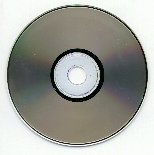
TriDVD-Preview

Stereo3D - DVD/MPEG-2 video technology for the PC by
Neotek
and 3DTV Corp.
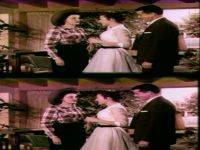
Jane Russel in 3D-action
and for the first time flicker-free!

TriDVD-Preview

Stereo3D - DVD/MPEG-2 video technology for the PC by
Neotek
and 3DTV Corp.

Jane Russel in 3D-action
and for the first time flicker-free!
|
|
|
Playback-Equipment TriDVD Software Package in Detail Sample Images Drawbacks |
Related Links:
Michal
Husak's 3D-MPEG-1/2 page - free software!
Page initially released on January 24, 1998
Last update on:
|
|
There are lots of 3D-videos for shutterglasses in VHS format on the market. They make up for a cool gag, but nothing more. The constraints of the NTSC and PAL TV formats and the VHS system are just too severe. Television only works at 50 or 60 Hz frequency giving shutterglasses applications a really nasty flicker. VHS video is known for it's low resolution. Combining the graphics power of the PC and the image quality of MPEG-2/DVD is a natural choice. Problem is that the common interleaved line stereo format often used in Stereo3D applications on the PC is not a good basis for MPEG-2 or whatever compression. Using the above-below 3D-image format known from professional applications and H3D/Wicked3D-games solves this problem. The MPEG-2 algorythm has no problems with this and combined with a sync-doubler controller very high refresh rates are easy to achieve.
|
|
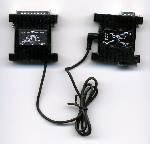
Neotek Model SSN sync-doubling
shutterglasses controller
was designed primarily for 3D-DVD video.
It's triggered by a proprietary code on the parallel port.
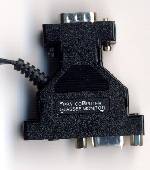
The Neotek Model SS sync-doubling
shutterglasses controller
is also supposed to work for 3D-DVD.
It uses it's own proprietary line-code-pattern.
Since I don't have a MPEG-2/DVD hardware decoder board I had to use
a software decoder. Unfortunately a 3rd party decoder doesn't support the
proprietary Neotek codes for the Neotek shutterglasses controllers. So
I couldn't see the 3D-effect until I came accross the new H3D
Activator.
Using the Activator to get my H3D-controller into sync-doubling mode
I was ready to go.
What should I say? Although there is room for improvement regarding the image quality of the samples I was blown away! Forget about 3D-VHS tapes! At DVD resolution and 120 Hz refresh rate it beats analogue TV/Video in every respect. This is the only convincing way to watch 3D-movies at home! The 3D-effects are convincing and the absense of flicker allowed me to really enjoy 3D-Video for the first time ever.
Neotek will improve the controllers and software over time of course, so it should work with the original equipment under any conditions when the system hits the market.
|
|
The TriDVD preview sample CD dated 8/98 contains:
1.) TriDVD stereoscopic DVD player software
2.) three Adobe Premiere plugins for creating Neotek format
stereoscopic
video from field sequential or separate left & right
sources
3.) a demo version of DVMPEG, a software MPEG2 encoder
4.) sample Neotek format stereoscopic video files
ad 1) TriDVD stereoscopic DVD player software
The 'readme' says:
The TriDVD playback software is designed for use with MPEG2 playback
cards such as Creative PCDVD Encore and Sigma Designs ReelMagic.
The
software uses the Microsoft Video for Windows interface to play
video
files from DVD, hard disk or even a fast (16x or better) CD drive.
It also controls the Neotek LCD shutter glasses interface to switch
automatically into sterescopic mode.
Well, well, now who has a DVD-decoder card? Virtually nobody and nobody will want one, because in the near future everyone will use MPEG-2-software playback Same story as with MPEG-1. On my el cheapo overclocked Celeron 450A it already runs smooth.
ad 2): three Adobe Premiere plugins for creating Neotek format stereoscopic
From the manual:
These three plugins were written for creating Neotek format
stereoscopic
video using Adobe Premiere for Windows, version 4.2
or above. They
should run on all 32 bit Windows platforms. To
install them, simply
copy them to your Adobe Premiere plugins folder.
Fx-TriD.prm:
This is a "transition" which combines separate left
and right (A and B)
clips into a single Neotek format stereoscopic clip.
Choose "TriDVD"
from the transitions menu in Premiere.
Fl-TriD.prm:
This is a "filter" which converts field sequential
stereoscopic clips
into Neotek stereoscopic format. Choose "TriDVD"
from the filters menu.
Fl-TriD2.prm:
This filter is like Fl-TriD above, but with an extended
setup dialog
to allow parallax correction on a scene-by-scene basis.
The preview
window is designed for viewing with 3DTV SpaceSpex
anaglyphic glasses,
but parralax can be adjusted without glasses.
Choose "TriDVD 2" from
the filters menu in Premiere. As of August 1998
this filter is still
under development and has not been tested extensively.
ad 3): a demo version of DVMPEG, a software MPEG2 encoder
From the manual:
DVMPEG, from Darim Vision, is available from http://www.darvision.com
or
http://darvision.kaist.ac.kr. It is a Video for Windows codec
which allows
programs such as Adobe Premiere to save video files in DVD standard
MPEG2
format. We have included version 4.32 on this CD, but check
their web site
for frequent updates. To install this codec, just double-click
on
dvmpeg4d.exe on this CD and follow the instructions.
ad 4) sample Neotek format stereoscopic video files:
The Neotek stereo video files seem to be nothing else than plain MPEG-2 files which show an above-below image.

NuView and TriDVD could make a dream-team!
This doesn't make analogue video equipment, like the NuView obsolete. It makes sense for the first time! It's required to shoot 3D-videos. Later the videos should be transferred from Hi8, miniDV or whatever to the PC, converted to above-below format and stored as MPEG-1 or MPEG-2.
|
|
Some stills from the TriDVD Stereo3D MPEG-2 samples.
Click to enlarge!
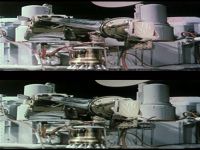 |
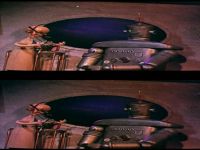 |
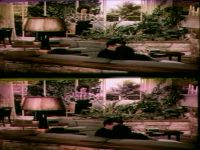 |
 |
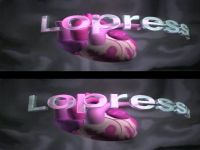 |
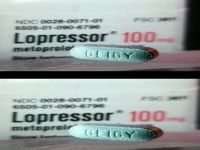 |
Use some sync-doubler shutterglasses to watch in 3D!
H3D instructions: To watch the sample images in stereo use a full-screen image-viewer, set your screen-mode to 24 or 32 bit colors at 60 Hz refresh and activate your H3D glasses in top-bottom non-interlaced mode using the H3D Activator.
|
|
- The main drawback of all shutterglasses applications remains - the crosstalk/ghosting, but there are less hard contrasts as in computer games. The overall impression is still very good.
- It won't work on stand-alone DVD-players connected to a TV-set.
- It won't work on HMDs, unless they support above-below 3D-image-format. HMDs would have the advantage of being ghost-free!
- It won't work on non-sync-doubler shutterglasses, such as SimulEyes, VR-Joy, Cyberboy, VRSurfer, etc.
Special thanks to 3DTV Corp.
Brand and product names are trademarks or registered trademarks of their
respective holders.
The author can not guarantee the accuracy of the information given
on this page.
Christoph Bungert, Germany .